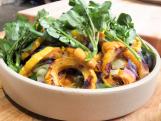How to Pack a Perfect Lunch


For people between the ages of 5 and 23, going back to school is a standard — and sometimes unsettling — part of life. We've put together easy recipes and food tips to help make the entire experience way more appetizing.
If you do it right, a packed lunch can be more exciting and way more nutritious than anything you can buy at the neighborhood deli. Whether you’re packing lunch for kiddos or for yourself, here are things to keep in mind:
1) Make it visually appealing. Colorful foods are exciting, and an array of colors is also good for you (as long as you’re getting those pretty colors from strawberries and yellow peppers, not cheese puffs and Kool-Aid).
2) Keep it balanced. For a lunch to be satisfying and keep you going through the afternoon, it needs three main components: protein (such as tuna, peanut butter, tofu, roasted chicken, yogurt), whole grains (could be 100 percent whole-wheat bread, crackers or wraps, leftover cooked grains, baked tortilla chips) and fruits and/or vegetables (celery sticks and dip, grapes, apples). Protein and the fiber from the whole grains will fill you up and keep you satisfied. Most adults need about 5 cups of fruits and vegetables a day, meaning you should try to have some with every meal.
3) Make it varied. I brought the same lunch to school every day of high school: a peanut butter sandwich. It was easy, but it was also boring. Changing up the contents of your lunch — different snack, different protein, different whole grain — will keep it interesting and also help you have a more varied diet.
4) Add snacks. Lunch is a nice break in the day. Make it something you look forward to by adding something fun — fresh berries, some chocolate chips and nuts, or a leftover portion of last night’s dessert (leftover fruit crisps are a favorite of mine).
5) Use an ice pack. Chances are something in your lunch needs to be kept cold, whether it’s yogurt or a turkey sandwich. Use an ice pack or a frozen juice box or bottle of water; it will thaw until lunchtime, cooling your lunch in the process.
6) Consider texture. A packed lunch needs to sit for several hours — maybe even overnight. You’ll need to pack things that won’t lose their texture. If you’re making a sandwich, make sure to line the bread with lettuce so the filling doesn’t make the bread soggy. Pack crunchy fruits and vegetables — carrot and celery sticks, grapes, apples — that hold up well. Keep dressings and dips in separate containers.
7) Use leftovers. Put leftovers to work by bringing them to work. Pack them up in individually portioned containers at the end of dinner so you can just grab and go when you're heading out the door in the morning. You can also reinvent leftovers: Tuck roasted meat or poultry into a sandwich, or add cooked veggies to a salad.
Kerri-Ann is a registered dietitian and nutrition coach who writes on food and health trends. Find more of her work at kerriannjennings.com or follow her on Twitter @kerriannrd or Facebook.












